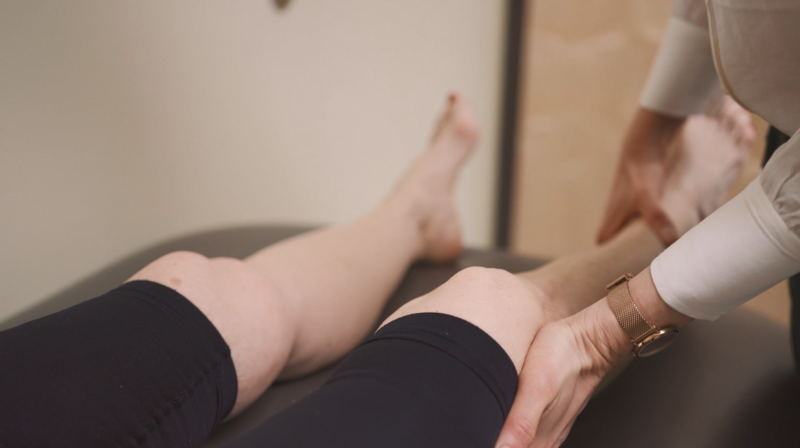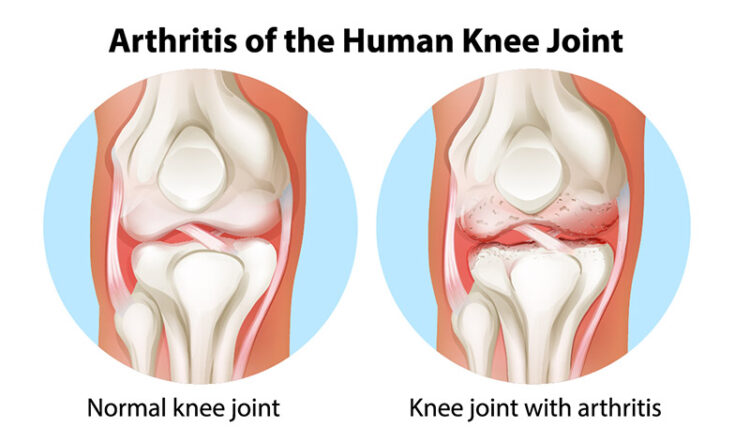
Making the decision to have orthopedic surgery requires careful consideration and a solid understanding of what your procedure and recovery will entail. If you are experiencing regular knee pain or knee arthritis, and noninvasive treatments such as medication and physical therapy are not relieving your symptoms, it may be time to discuss joint replacement surgery as an option with your doctor.
There are many reasons why your doctor might recommend a total knee replacement, ranging from knee pain while resting to chronic inflammation or swelling of the knee. In general, you may be a candidate for knee replacement if you are experiencing severe knee pain or stiffness that limits your everyday activities like walking or running, climbing stairs, or sitting down in a chair.
A Look at the Knee Joint
The knee functions as a hinge joint, which means bones move in one direction back and forth with limited motion in other directions (think of the hinge on a door). Hinge joints are complex and contain many different muscles and tissues – the fingers, toes, elbows, and ankles are also hinge joints.
Your knee is made up of three main bones: the femur, the tibia, and the patella (kneecap). In a healthy knee, cartilage coats the bones in the knee joint to help it move smoothly and provide a shock-absorbent cushion. In an arthritic knee, the cartilage surface starts to break down resulting in bone-on-bone contact that causes pain, stiffness, and swelling. Several conditions can cause knee pain, but arthritis and overuse injuries are the most common causes of chronic knee pain.

Questions to Ask Before Total Knee Replacement Surgery
What is a knee replacement?
Total knee replacement surgery is a common and effective procedure that can relieve pain and help you get back to your favorite everyday activities. Approximately one million hip and knee replacement surgeries are performed in the United States each year. The goal of the surgery is to replace arthritic joint surfaces in the knee with prosthetic components made of metal and plastic, allowing the joint to function properly again and ultimately relieve knee pain. These implants are highly trusted by orthopedic surgeons and have been perfected over many years.
Is a partial knee replacement or a total knee replacement best for me?
This is an important question to discuss with your orthopedic surgeon, and the answer will depend on the condition of your knee and the parts of your knee that are affected. Most patients who require knee replacement surgery will need a total knee replacement, but sometimes only one section of the knee is impacted and a partial knee replacement will suffice. Partial knee replacements do typically have a quicker recovery time, but are generally not the best option for anyone suffering from acute arthritis of the knee.
Am I a candidate for Mako robotic-arm assisted surgery?
Your orthopedic surgeon will provide you with as much information as possible to make the best decision for your unique situation. Mako robotic-arm assisted technology is an option that provides patients with a precise, personalized surgical plan based on a CT scan that matches the implants to your anatomy. A three dimensional model of your knee is created and used by your surgeon to guide a state-of-the-art robotic arm to align, position, and secure the implant. It is important to remember that robotic-arm assisted technology is a useful tool and is certainly an option for some patients, but it is not a necessity and surgeons have been successfully performing standard instrumentation knee replacement surgeries for decades.
What are some of the preoperative instructions for a total knee replacement?
Your orthopedic surgeon will encourage you to maintain a healthy weight to relieve any excess pressure on the knee joint. A balanced diet and regular exercise are important to manage blood sugar and blood pressure. Schedule a visit with your primary care provider pre-surgery to run a basic lab panel and ensure your heart and lungs are in good shape to handle anesthesia. If you are having your surgery at Cascade Surgicenter, you will meet with your surgeon or his/her physician assistant prior to your surgery to receive education about the surgery and answer your questions. If you are having your surgery at St. Charles hospital, they offer a total joint class for patients that dives deeper into the details of what to do (and what not to do) before and after surgery.
Are there any strengthening exercises I can do before surgery to build muscle around the joint?
Depending on your pain and ability levels, low-impact exercises like walking or getting on the elliptical or stationary bike are a great option pre-surgery. Anything you can do to keep the knee moving will keep fluid in motion, keep the capsule loose and improve the outcome of your surgery. Avoid high-impact movements like hiking up and down hills, running, basketball or soccer.
What are the Risks of Total Knee Replacement Surgery?
All surgeries can have complications either during or after the procedure. Your care team will discuss these risks in depth with you.
Occurring at a rate of about 1%, there is always a risk of having an infection. In some cases, your orthopedic surgeon can clean out the joint and change the modular parts. Other cases may require further surgery. Some other rare complications (~1-2%) include heart attack, stroke, blood clots, kidney failure, fracture, stiffness, dislocation, and the need for redo or revision surgery.
Questions to Ask About Knee Replacement Surgery
Are there any Nonsurgical Treatment Options I should Consider?
When a patient is ready to address their arthritis, treatment will first be approached from a nonsurgical standpoint. Our orthopedic doctors in Bend have a number of different nonsurgical options they will first discuss with their patients and have them try before considering surgical treatment options.
Some of these nonsurgical recommendations could help slow the progression of arthritis in the knee:
- Minimize activities that aggravate the condition, such as climbing stairs.
- Switching from high-impact activities (like jogging or tennis) to lower impact activities (like swimming or cycling) will put less stress on your knee.
- Losing weight can reduce stress on the knee joint, resulting in less pain and increased function.
Other nonsurgical treatment options to help with arthritis pain relief:
-
- Physical Therapy
- Assistive Devices
- Applying heat or ice, using pain-relieving ointments or creams, or wearing elastic bandages to provide support to the knee may provide some relief from pain.
OTHER NONSURGICAL OPTIONS TO HELP EASE ARTHRITIS PAIN:
- Physical Therapy
- Assistive Devices
- Applying heat or ice, using pain-relieving ointments or creams, or wearing elastic bandages to provide support to the knee may provide some relief from pain.
How long will my total knee replacement surgery take?
The duration of the actual knee replacement surgery is fairly quick and usually only takes your surgical team about two hours to complete, depending on the difficulty of surgery. However, your entire procedure will be a longer time commitment when you factor in arrival time and anesthesia. Most patients are required to arrive at least two hours prior to surgery, and spinal anesthesia can last as long as five hours for some patients. The entire length of your surgery day will also depend on whether or not you are a candidate for outpatient knee replacement surgery.
What does the surgery entail?
Your orthopedic surgeon will make a front-of-the-knee incision running directly over the knee cap. Once the knee cap has been moved aside, your surgeon will be able to place the implants covering all surfaces of the knee. The anterior cruciate ligament (ACL), meniscus pads, bone spurs and sometimes the posterior cruciate ligament (PCL) are all removed, while the medial collateral ligament (MCL) and lateral collateral ligament (LCL) are maintained.
- The damaged portions of the femur, tibia, and cartilage are cut away. The bones may be slightly reshaped to create a perfect fit for the implant.
- Implant components will be attached to the femur and tibia using bone cement. A polyethylene insert is attached to the metal component to act as cartilage between the two bones.
- The femur and tibia are placed back together to form a new joint. To make sure the kneecap moves smoothly over the surface of the joint, another polyethylene component is cemented to the back of the kneecap.
Questions to Ask About Total Knee Replacement Recovery
What does the recovery process look like?
Joint replacement recovery is extremely variable and depends greatly on your level of activity and conditioning before surgery. Maintaining muscle strength and mass is very important and typically patients who are more active pre-surgery are also more active post-surgery. Generally speaking, a knee replacement should regain full motion in approximately six to eight weeks with an increase in mobility in the following months. We typically see patients traveling and walking with minimal discomfort in the three month post-surgery range, and regaining full, pain-free function in about six to twelve months.
How long before I can get back to mild sports and other activities?
Again, recovery time will vary, but this can typically happen as soon as three to four months after surgery. It really depends on what the activity is. Doubles tennis might take longer to get back to compared to something like golf. Unfortunately, many orthopedic surgeons don’t encourage running after a total knee replacement due to the stress and impact it puts on the joint that can wear out the implant over time. Walking and hiking are typically better options for total knee replacement patients.
Will my leg be longer or straighter after surgery?
No, this isn’t the case with total knee replacements. Your surgeon will balance your knee replacement using ligaments, which do not change in length. There may be minor changes to the alignment of your knee joint making it appear straighter if you were previously out of alignment, but leg length will not change.
Will I be able to kneel after a total knee replacement?
Many patients doing activities like home finishing, renovations, or even gardening find it takes a year or longer for sensitivity while kneeling to dissipate. Some find relief through heavy-duty knee pads if this type of work is necessary, or you can try using a thick pad on the ground beneath you. Knee replacement patients are not forbidden from kneeling, but most patients experience some discomfort when trying to kneel.
How long will I need someone to assist me after surgery?
Most patients find it helpful to have someone with them for the first week post-surgery. After that, you’ll be able to be on your own more independently, but it is helpful to have someone nearby who you can call for assistance when needed and who may be able to drive you to physical therapy appointments.
How long will my knee replacement last?
This varies depending on the patient, but knee replacement implants are very strong and durable. With today’s advancements in technology, especially when it comes to polyethylene, knee implants are lasting more than 15-20 years for most patients.
If you and your orthopedic surgeon have decided that you are a good candidate for total knee replacement, start planning ahead so you can focus on your recovery for the best possible outcome. Remember that you’re likely to come out of surgery as active as you go into surgery, so aim for regular low impact exercise and joint movement that you can complete without pain. Carefully following your surgeon’s instructions after a total knee replacement will ensure protection of your implant and prolong the success of your joint replacement.
We’ve put together a free guide to help you better understand joint replacement preparation, orthopedic surgery, and recovery. If joint replacement surgery is the best solution for you, The Center’s orthopedic surgeons and support staff are ready to help you prepare for surgery and plan for a successful recovery. Click below to sign up and receive our free joint replacement guide.
Stay informed about upcoming webinars and events, and gain valuable insights on leading a healthy, pain-free life from our experts by subscribing to our monthly newsletter. Click the button below to join!





